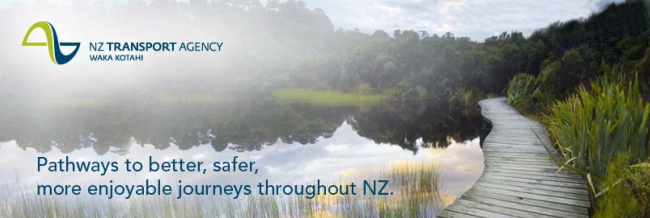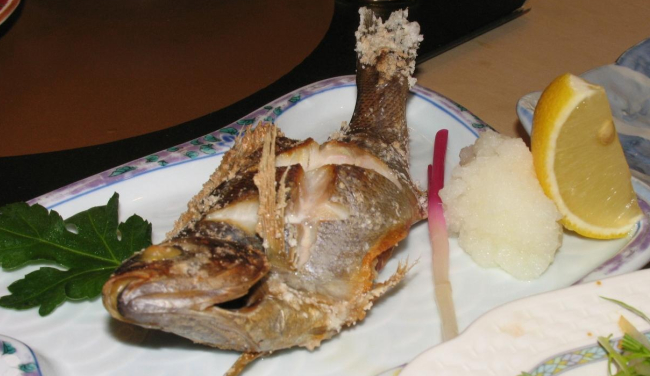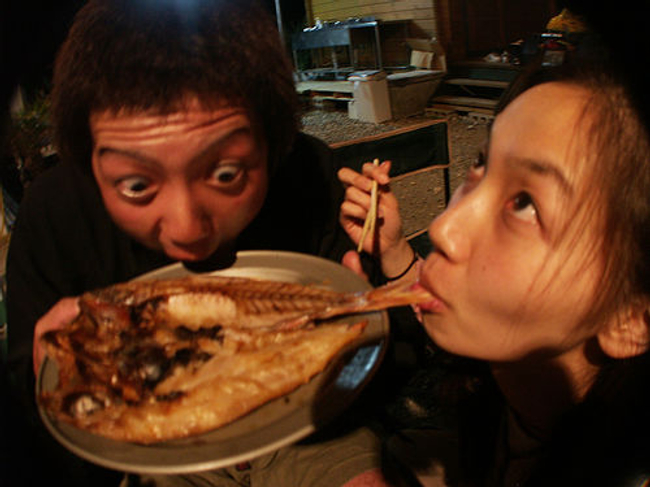The latest iteration of what was once Transit, now called the NZ Transport Agency, (obligatory maori moniker: Waka Kotahi) is now into publishing.
Edition no. 3 of Pathways is glossy and cheerful, and like most of the recent publications from recently re-organised public service departments, entirely full of bumpf and platitudes with nothing much useful to say at all. One article however was worse than plain useless: it was simply plain wrong.
The author was off on a simile voyage, claiming that designing roads was like being a master chef:
“The planning of walking and cycling facilities in New Zealand resembles dinner at a fine restaurant. You enjoy your appetiser, you fill up on your main meal and if you have some money or room left, you order some desert.”
He (senior Policy Advisor Jason Morgan) goes on to say that
“In a sense, walking and cycling have moved from the dessert menu right into the main course. A little bit of creme brulee on the side of your filet mignon, if you like.”
So: a master chef (road builder) would have to have a little creme brulee (cycle path) on the side of the filet mignon (main highway).
Not only would this be a truly horrendous looking and tasting meal, but it is also entirely the wrong thing to do. To continue the NZTA’s chef awful simile, what they appear not to understand is that to be a cyclist is more like requesting a completely vegetarian dish, as opposed to the all meat and two vege alternative on offer. Cyclists are certainly not pudding, and like vegetarians, don’t really appreciate a dribbling of rare beefsteak juice leaking onto their side of the plate either.
Continuing this awful line in simile to its logical conclusion then (don’t blame me – they started it), you also need to offer a fish dish (public transport): again, not contaminated by either the beef (cars) nor dribbling fish sauce onto the vegetarian’s salad. The fish dish of course is the dish for all of us – acceptable to most vegetarians if not the full vegan option, and happily scoffed down by the meaty boys if there is enough cheese sauce on top. Like fish, the train or bus options need to be carefully quota managed so as to not exhaust the fish stocks, and if managed well, we can all eat very healthily.
As the New Zealand Transport Agency, you need to concentrate on providing healthy wholesome dishes for all New Zealanders to enjoy, with a range offering beef, fish and veges for all of us kiwis, in big and small servings. Just offering the beef only: my, my, those days are well and truly over, just like Cobb and Co last century. And the last thing we want is a Valentines Steak House with huge juicy slabs of dead cow, and some hideous Chef’s special with pudding stirred in. That just won’t do at all.
So, Waka Kotahi – petrol-heads and bad chefs all of you, understand this: offer fillet mignon to those that want it, and then offer a completely separate clean plate with a freshly washed, wholesome all vegetable dish on, full of carrots and a nice green lettuce. Keep the beef well away! No bloodstains on the tablecloth! Only then will the customers be calling out to Chef, “Seconds please!”
And forget about the creme brulee simile – you should know by now that you can’t have any pudding till you’ve finished your dinner.









The banner graphic sums up much of the falafel for me actually, in that it relies upon the great scenic beauty of NZ’s ‘natural’ environment. Until we can get past that particular fetish, and begin to consider the built environment as potentially being ‘beautiful’, organizations such as the Transport Agency just aren’t going to catch on to what an important role they play – and raise the stakes accordingly (and in relation to all modes of transport).
That our urban transport is so ugly (and I include functional stupidity in my definition of ugly), that they can’t feature it on their own banner, is an indictment largely of their own efforts
Nothing raises my hackles like dumb myth adherence anyway…
PS – I bet you didn’t realize that the post would sneak through the black-out via the feeds…?
“In a sense, walking and cycling have moved from the dessert menu right into the main course.
When I read those quotes, I mentally hear them in the voice of Murray from Flight of the Conchords.
It’s all a bit like “Look at you, you people who walk everywhere. Can’t afford a car, eh? I suppose you want a footpath along the side of the road and some pedestrian crossings, eh? Well, some of us need our meat first, so you’ll just have to wait.”
M-D: You’re so right about the graphic. Whenever New Zealand is represented in photos, it’s never ever urban areas. Yet that’s where most of us live. Officially, we all seem to be ethereal creatures, who just happen to exist somewhere around the Southern Alps or a pohutukawa flanked beach.
Last year the Auckland City Council put posters all over the inner city encouraging people to cycle. I appreciated the enthusiasm as I would really love to cycle myself, but painting pictures of cyclists on the road and putting up posters is not going to stop the cars driving over the top of cyclists and hurting them. I think they need to snort some horseradish and wake up.
Hmmm, this is interesting. The Wellingtonian has just put out an issue with, at last, some feedback on the Bypass. I like the part where it says that Steve Harte, of WCC traffic dep, is “unaware of any downsides”.
Entitled “Has the Bypass worked?” http://www.stuff.co.nz/dominionpost/4851684a27348.html
JIM CHIPP – The Wellingtonian | Wednesday, 18 February 2009
Wellington’s inner-city bypass has been in operation for two years, time enough for people to find their way around it and to establish favoured routes. The Wellingtonian set out to discover what users think of it. Has it produced the travel time savings promised? Has it proved the community-dividing schism some feared? The Wellington regional director for the New Zealand Transport Agency, Deborah Hume, says the bypass is working well.
What do the punters say?
Cabbies
Most cabbies The Wellingtonian spoke to think the bypass has brought benefits of speedier travel around town.
Taxi driver Burhan Hussein, who has driven Wellington’s streets for seven years, gives the bypass an unqualified thumbs up. “It is much easier to get to the motorway,” he says. Travel between the airport and Brooklyn had also been sped up with most Mt Victoria tunnel traffic heading to Vivian St.
Travel across the bypass, between the CBD and Brooklyn or Mount Cook, was also quicker, with four lanes splitting traffic and shortening queues. Hussein estimates he uses the route 20 times a day and thinks it saves him up to an hour a day.
Another taxi driver, who declined to give his name, also says the bypass is good for him and he wouldn’t change any aspect of it. “From my point of view, it’s very good,” he says. “The way it is at the moment is the best way.” A third, Abshir Mohamed, says it has sped up fares between the airport and Hutt Valley. “It wasn’t easy before. You had to go to Vivian St and there was a lot of traffic.”
Cyclists
Cyclists aren’t so pleased with the bypass. Cycle Aware spokesman Patrick Morgan says more and faster traffic is bad for cyclists. “It tends to divide the northern and southern parts of the town and it’s hard to cross. Cyclists using the cycleways are in conflict with walkers at the Cuba St intersection. It means cyclists tend not to use the cycle facilities, [they] tend to ride on the road.”
However, it’s not all bad news, he says. “One good thing is that the left-hand lane is the widest lane. That’s something we did ask for and they delivered on.”
Pedestrians
Celia Wade-Brown, president of walking advocacy group Living Streets Aotearoa, isn’t impressed by the new route.
“My observation is that there are parts where there are nice wide footpaths, but it’s not parts where people actually want to walk,” she says. At Willis St’s controlled zebra crossings, pedestrians are waiting longer than they did before, she says. “Minor improvements going east-west are not actually helpful to north-south-travel pedestrians coming from Brooklyn to the city.”
The pedestrians The Wellingtonian spoke to didn’t agree. “It seems all right,” one said. “Traffic at five o’clock is always congested on Victoria St, [but] as to getting to the airport, it’s good.”
Rat runs
Wellington City Council transport network development manager Stephen Harte says the bypass has improved transport in Wellington, reducing cross-city travel time to regional facilities such as the hospital and airport and making it more consistent.
“Before, there could be anything up to a 20-minute difference in journey time.”
Harte is unaware of any downsides. “[There have been] grumbles at times from people having to change their routes, but people are fairly amenable about finding what works for them best, once they get over changing the habits of a lifetime.”
Anecdotally, The Wellingtonian has heard more motorists are travelling between the western suburbs and the southern suburbs by driving down Aro St, up Ohiro Rd and right on to Wallace St via Brooklyn Rd and Bidwill St to avoid waiting at the bypass lights.
Harte says council officers are aware a few more people use that route. “[But] it’s a perception thing. If they timed themselves they would probably find they do it quicker on the arterial routes.”
M-D – to be fair to Transit / NZTA – their banner changes, and turns to the Harbour bridge in Auckland as well.
I am very suspicious of the beautiful little wooden path through the lakeside as pictured though – was that REALLY a transit pathway? Did they plan it and get it built? I’d really love to know. But i’d wager that they had nothing to do with it….
Anyone from NZTA want to own up and tell us all? Come on, we know you’re watching…
Yeee Gad! What drivel! I wish the people who write such reports would realise that such elaborate metaphors should be used only to elucidate the contents of the report, not to fill up space when there aren’t enough photos of Pohutukawas. The metaphor of the NZTA as chef really calls out to taken to its (possibly unfair conclusion): After we’ve been served the weird beef-brulee we eat it anyway — no mater how distastefull it is — (even the vegetarians?) because we’d starve if we didn’t. The final form of whatever we’re served is inevitably the same; just so much s–t.
It all leaves one feeling that if the fillet (with or without the side of creme brulee) isn’t your thing, you’d be better to stay at home and make yourself an omelette.
“Hmmm, this is interesting.”
… but also interesting that the Arch Centre (www.architecture.org.nz) is also making culinary connections with transport. Telepathy … or something in the air … or on the dinner plate …?
Or perhaps just that someone at the Arch Centre is perhaps reading the Sunday Star Times, which says:
Kiwis still hooked on the unhealthiest food
ESTHER HARWARD – Sunday Star Times | Sunday, 22 February 2009
http://www.stuff.co.nz/sundaystartimes/4855596a6005.html
DESPITE YEARS of warnings about the perils of a poor diet, Kiwi shoppers are piling supermarket baskets high with soft drink, white bread and other unhealthy foods laden with sugar, salt and fat…..
….The top 10 items sold in Supermarkets…
1. Coca-Cola 1.5l
2. Wattie’s spaghetti 420g
3. Coca-Cola 2.25l
4. QB Nature’s Fresh white toast 700g
5. Wattie’s baked beans 420g
6. Dole bobby bananas (850g)
7. Tip Top super soft white toast 700g
8. Sprite lemonade 1.5l
9. QB Molenberg original toast 700g
10. Coke Zero 1.5l
I’m sure there is some connection between bad diet and bad skin, but i have no idea whether there is a connection between bad food and bad roading. Bad roadies, maybe.
To be fair to NZTA, they are trying hard to be more inclusive of bicycles and pedestrians than they were in their old pre-nzta “Transit” days – they merged 2 or 3 different transport departments, and they now have an obligation to have a more integrated approach to NZ’s transport systems. They say in their fluff that NZTA will have 4 transport outcomes – integration, safety, sustainability, and value for money.
They’re working to a government (from Aug last year, under a dying Labour gov, so it could of course get rescinded at any time) Transport Strategy, which has goals to:
– be one of the first countries in the world to widely use electric vehicles
– use more renewable fuels
– increase freight by coastal shipping and rail by 25 / 30 % by 2040
– reduce single-occupancy vehicle trips by 10% by 2015
– reduce road deaths to 200 per year
All of which is interesting, but kind of vague when it comes to rail and cycling etc. I would have thought there would need to be a clear statement on exactly what it is in charge of. Is it, for instance, in charge of OnTrack, the government rails company? Or is it in charge of KiwiRail? Does it intend t buy a NZ Coastal shipping boat – how else is it to get coastal shipping to increase? Rely on Ngai Tahu to buy a schooner and set up kumara shipments around NZ as it did 150 years ago?
I also question whether an Agency full of roading designers is ever going to work and suddenly blossom into life as a state-of-the-art cycling and rail advocate and cycle-path designer. How are they going to do that? Surely they’ll need to have a swathing cut and delete some of the old road nazis, and instead import a whole lot of Danish or Dutch cycle-path designers, to have the faintest chance of ever altering the mindset?
rondo, I was wondering a similar thing (re: types of engineers). Wonder if its worth asking their public relations what they are going to do in that regard. Even just hiring on a couple of high positioned people who can be champions for PT and active transport within the department might help. And some procedure/policy changes that simple require engineers to compelte alternatives assessments for any project with PT and etc involved (or something to that effect) might be a great step.